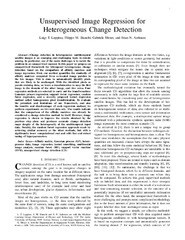Browsing Artikler, rapporter og annet (fysikk og teknologi) by Author "Luppino, Luigi Tommaso"
-
Change Detection with Heterogeneous Remote Sensing Data: From Semi-Parametric Regression to Deep Learning
Moser, Gabriele; Anfinsen, Stian Normann; Luppino, Luigi Tommaso; Serpico, Sebastian Bruno (Conference object; Konferansebidrag, 2020) -
Clinically relevant features for predicting the severity of surgical site infections
Boubekki, Ahcene; Myhre, Jonas Nordhaug; Luppino, Luigi Tommaso; Mikalsen, Karl Øyvind; Revhaug, Arthur; Jenssen, Robert (Journal article; Tidsskriftartikkel, 2021)Surgical site infections are hospital-acquired infections resulting in severe risk for patients and significantly increased costs for healthcare providers. In this work, we show how to leverage irregularly sampled preoperative blood tests to predict, on the day of surgery, a future surgical site infection and its severity. Our dataset is extracted from the electronic health records of patients who ... -
Deep Image Translation With an Affinity-Based Change Prior for Unsupervised Multimodal Change Detection
Luppino, Luigi Tommaso; Kampffmeyer, Michael; Bianchi, Filippo Maria; Moser, Gabriele; Serpico, Sebastiano Bruno; Jenssen, Robert; Anfinsen, Stian Normann (Journal article; Tidsskriftartikkel; Peer reviewed, 2021-02-17)Image translation with convolutional neural networks has recently been used as an approach to multimodal change detection. Existing approaches train the networks by exploiting supervised information of the change areas, which, however, is not always available. A main challenge in the unsupervised problem setting is to avoid that change pixels affect the learning of the translation function. We propose ... -
Heterogeneous Change Detection with Self-supervised Deep Canonically Correlated Autoencoders
Figari Tomenotti, Federico; Luppino, Luigi Tommaso; Hansen, Mads Adrian; Moser, Gabriele; Anfinsen, Stian Normann (Conference object; Konferansebidrag, 2020) -
Predicting Regions of Local Recurrence in Glioblastomas Using Voxel-Based Radiomic Features of Multiparametric Postoperative MRI
Cepeda, Santiago; Luppino, Luigi Tommaso; Pérez-Núñez, Angel; Solheim, Ole Skeidsvoll; García-García, Sergio; Velasco-Casares, María; Karlberg, Anna Maria; Eikenes, Live; Sarabia, Rosario; Arrese, Ignacio; Zamora, Tomás; Gonzalez, Pedro; Jiménez-Roldán, Luis; Kuttner, Samuel (Journal article; Tidsskriftartikkel; Peer reviewed, 2023-03-22)The globally accepted surgical strategy in glioblastomas is removing the enhancing tumor. However, the peritumoral region harbors infiltration areas responsible for future tumor recurrence. This study aimed to evaluate a predictive model that identifies areas of future recurrence using a voxel-based radiomics analysis of magnetic resonance imaging (MRI) data. This multi-institutional study included ... -
Remote sensing image regression for heterogeneous change detection
Luppino, Luigi Tommaso; Bianchi, Filippo Maria; Moser, Gabriele; Anfinsen, Stian Normann (Conference object; Konferansebidrag, 2018-11-01)Change detection in heterogeneous multitemporal satellite images is an emerging topic in remote sensing. In this paper we propose a framework, based on image regression, to perform change detection in heterogeneous multitemporal satellite images, which has become a main topic in remote sensing. Our method learns a transformation to map the first image to the domain of the other image, and vice versa. ... -
Unsupervised Image Regression for Heterogeneous Change Detection
Luppino, Luigi Tommaso; Bianchi, Filippo Maria; Moser, Gabriele; Anfinsen, Stian Normann (Journal article; Tidsskriftartikkel; Peer reviewed, 2019-08-14)Change detection (CD) in heterogeneous multitemporal satellite images is an emerging and challenging topic in remote sensing. In particular, one of the main challenges is to tackle the problem in an unsupervised manner. In this paper, we propose an unsupervised framework for bitemporal heterogeneous CD based on the comparison of affinity matrices and image regression. First, our method quantifies ...


 English
English norsk
norsk





